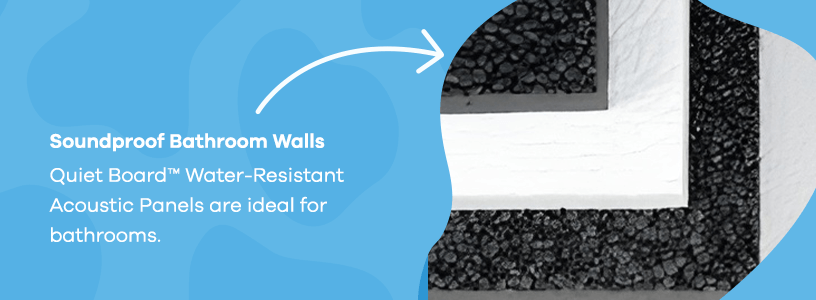
At home or in the office, this is one room where you do not want sounds escaping. That is where soundproofing comes in. From simple tips to sound-deadening materials, there is a bathroom soundproofing solution for everyone.
So, let us dial down unwanted noise and turn up the volume on tips for soundproofing your bathroom!
Start With Simple Bathroom Soundproofing
Think you need a physics degree and a second mortgage to soundproof a bathroom? Think again.
When sound encounters an object, it either reflects into the room or the object absorbs it. Placing sound-absorbing items in the bathroom helps to break up sound waves. Here are some ideas to try:
- Fluffy towels: Packing plush towels on shelves can help absorb sound.
- Thick rugs: Like towels, a chunky rug can absorb sound waves.
- Cabinets: Installing shelves or cabinets adds surfaces to deflect sound. Plus, you get added storage space.
- Soft accessories: Consider a woven laundry hamper or fabric-covered chair. Soft furnishings can accessorize your bathroom while absorbing sound waves.
If these options fail, it might be time to mooove on to serious soundproofing solutions.
Tips for Soundproofing a Bathroom
Transforming your bathroom into a soundproof sanctuary means addressing where the sound gets in or out. There are five noise-escaping areas — doors, walls, floors, ceilings and pipes.
1. Soundproof a Bathroom Door
The gaps around doors let sound in and out. You could replace your bathroom door with a sturdier, soundproof door, but there are the easier options:
- Door sweeps: The gap under the door can let sound escape. A product like the Quiet Door™ Automatic Door Sweep fits the bottom of the door to create a tight seal. Heavy-duty aluminum sweeps withstand bathroom moisture and temperatures. The “automatic” in its name means the sweep engages as soon as you close the door.
- Door seals: Want even more soundproofing power? Create a barrier around the door’s perimeter with Quiet Door™ Adjustable Perimeter Seals. A durable aluminum frame and silicone seals prevent sound transmission.
- Sealant: Use the OSI® Pro-Series SC-175 Acoustical Sound Sealant to seal cracks in door sills. This sealant adheres to regulations regarding volatile organic compounds and is nonflammable.
- Acoustic panels: Acoustic panels are a great choice when it comes to deadening sound. These attractive panels decrease echo and noise transfer. Installing a Quiet Door™ Acoustic Panel is as easy as peeling and sticking.
- Door kits: For ultimate convenience, door kits offer an all-in-one solution. These kits include a door sweep, perimeter seal, sealant and acoustic panel. You can also explore commercial door soundproofing kits.
Bathroom door soundproofing materials offer a cost-effective alternative to remodeling your bathroom.
2. Soundproof Bathroom Walls
Thin walls transform your bathroom into a loudspeaker, amplifying every sound.
If you want to drastically reduce unwanted noise and sound transfer here are some great products to get you on the right track.
- Soundproofing materials: These materials reduce inside noise and prevent outside noise from entering. The Quiet Barrier® HD Soundproofing Sheets are an easy way to block sound transferring through bathroom walls.
- Soundproofing insulation: Choose snug-fitting insulation to reduce sound and energy transfer between wall studs. Quiet Batt® Soundproofing Insulation is a safe and effective sound-deadening material.
- Soundproofing systems: The isoTRAX® Soundproofing System uses sound isolation rails to separate drywall from studs. The kit also comes with sound-deadening pads that decrease sound transmission.
- Echo absorption: Install Echo Absorber™ Acoustic Panels on any flat or curved surface.
- Acoustic sealant: Fill gaps with the handy OSI® Pro-Series SC-175 Acoustical Sound Sealant for soundproofing success!
The installation methods for new and existing bathroom walls differ. Do your homework before soundproofing a new vs. an existing wall.
3. Soundproof Bathroom Floors
The sound-reflecting qualities of bathroom floors depend on their construction material. For example, laminate flooring transmits echo and impact from footsteps. Tiles are a tough soundproofing nut to crack. Installing an underlayment is the best way to dampen noise, regardless of floor type.
Consider your flooring type for the best underlayment option:
- Tile, stone and hardwood: A rubber underlayment reduces noise and resists moisture. A product like PROFLEX™ 90 underlayment defies bathroom temperatures. This underlayment is comprised of a laminated rubberized membrane with reinforced fabric. That means no cracking or warping.
- Laminate or engineered: Address noise and echo with Impact Barrier QT Flooring Underlayment. This versatile underlayment reduces sound while resisting mold and mildew.
- Carpet: This is not a typical bathroom floor option, but if you have it, the Impact Barrier QT Flooring Underlayment provides extra noise reduction.
4. Soundproof Bathroom Ceiling
A ceiling may not seem essential for soundproofing, but if you live in an apartment or multilevel home, you might not want bathroom noises to escape upwards.
Like walls, the method depends on whether the ceiling is new or existing. Let us assume you want to soundproof an existing ceiling without tearing it up. Here’s how:
- Drop ceiling: A drop ceiling is a second ceiling below the first, with soundproofing insulation between. You can buy an Existing Ceiling Soundproofing Assembly with everything you need.
- Acoustic foam: The soft, porous acoustic foam traps sound energy and converts it to heat. Placing foam along the ceiling absorbs noise before it hits the reflective surface.
- Soundproofing barriers: Soundproofing membrane and polyurethane foam can block sound transfer through the ceiling. Quiet Barrier® HD Soundproofing Composite blocks noise and acts as a decoupler within a ceiling assembly.
- Hanging baffles: Baffled by how to soundproof your bathroom ceiling? The Udderly Quiet® Acoustic Baffle 200 Series traps and redirects sound for easy soundproofing.
- Repeat wall techniques: You can use the same wall soundproofing products to deaden bathroom ceiling noise.
5. Soundproof Bathroom Pipes
Plumbing pipes are among the biggest culprits of unwanted bathroom noise. The great news is that quieting noisy pipes is as easy as wrapping them up.
Enter Quiet Wrap™ Pipe Soundproofing Wrap! This tape combines a high-density sound barrier membrane with industrial-grade composite foam. The peel-and-stick siding makes it a breeze to install.
Wrapping bathroom pipes is as easy as one, two, three:
- Cut: Mark where you want to cut the wrap. You can measure it by wrapping the tape around the pipe and then cutting it.
- Peel: Strip 4 to 5 inches from the backing and place the sticky side on the pipe at an angle.
- Press: Push down to bond the wrap to the pipe, continuing until you have covered the pipe.
And just like that, you have pipe soundproofing all wrapped up!
Banish Bathroom Noises With Soundproof Cow
Our top priority is helping you create the perfect sound environment. Request a free acoustic analysis so that we can recommend the best soundproofing solutions for your space. You can also call us at 1-866-949-9269 or contact us online today!












